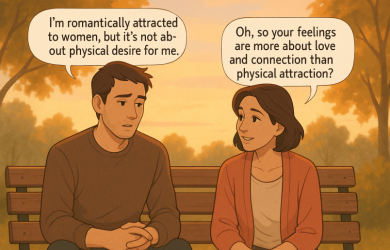5 Different Types of Being Demiromantic and Signs You’re One

Unlock Daily 30-Sec Tips for a Happier Relationship
👉 Subscribe FREEKey Takeaways
Marriage.com AI Quick Summary
How fast can you fall in love? Indeed, love can change anyone. While most of us would believe in love at first sight, the realm of demi-romanticism invites us to explore a different narrative.
Are you curious about people who are demiromantic? Discover deeper emotional connections. Transform relationships with patience, understanding, and a unique approach to love.
What does demiromantic mean?
If this is the first time you have read this term, this is a good start. Demiromanticism is a romantic orientation where attraction only occurs after forming a deep emotional connection.
Unlike our usual notion of falling in love at first sight, demiromantics only experience romantic attraction after confirming a deep emotional connection with someone special.
It means that initial physical or superficial aspects may not spark romantic feelings, requiring time and shared experiences to cultivate a profound emotional bond. Demiromantics value meaningful connections, emphasizing the importance of a strong foundation before venturing into romance.
The orientation challenges societal norms, nurturing relationships built on genuine emotional intimacy rather than fleeting infatuations, adding depth and authenticity to the journey of love.
How does being demiromantic differ from other romantic orientations?
Now that we know what demiromantic means, it’s time to differentiate it from other romantic relationships. Demiromanticism distinguishes itself from other romantic orientations by its distinctive approach to forming romantic connections.
It’s not your usual situation where you fall in love with someone. While individuals across the romantic spectrum may experience attraction in various ways, demiromantics stand out for requiring a deep emotional bond before experiencing romantic feelings.
In contrast to the immediacy of love at first sight, demiromantics prioritize substantial connections, often forged through shared experiences, trust, and mutual understanding.
It sets them apart from mainstream romantic orientations, such as those who identify as romantic or romantic-leaning, where physical or immediate emotional connection can ignite the spark of attraction.
Similarly, demisexuality, while sharing the emphasis on emotional closeness, primarily focuses on forming sexual attraction exclusively within established emotional bonds. Demiromantics challenge societal expectations by prioritizing substance over surface-level attraction, cultivating relationships that evolve organically.
In a world captivated by the instant gratification of suddenly finding yourself in love, a demiromantic offers a refreshing alternative, celebrating the beauty of slow-burning, authentic connections that withstand the test of time.
How common is being demiromantic?
“Are there many demiromantic people?” Determining the prevalence of demi-romanticism can be challenging due to the personal and subjective nature of romantic orientations. However, it is increasingly acknowledged and discussed within the spectrum of human sexuality.
While exact statistics are elusive, many individuals identify as demiromantic, contributing to a growing recognition of diverse romantic experiences. The rise of online communities and open conversations about non-traditional romantic orientations has facilitated greater understanding and acceptance.
As societal awareness expands, more people may recognize and embrace their demiromantic tendencies, highlighting the importance of acknowledging and respecting the diversity inherent in human relationships.
5 different types of being demiromantic
Demiromanticism is a term used to describe a romantic orientation where an individual only experiences romantic attraction after developing a strong emotional bond with someone. It falls under the umbrella of the broader category of romantic orientations. Here are five different types or variations of demi-romanticism:
- Slow-burn demiromantics: These demiromantic individuals experience a gradual progression of romantic feelings, allowing emotions to develop over an extended period rather than instantaneously.
- Experiential demiromantics: These shared experiences are the key to unlocking romantic attraction for this subtype. Meaningful moments and joint activities lay the foundation for deeper emotional connections.
- Intimacy-focused demiromantics: Prioritizing emotional closeness and vulnerability, this type requires a high level of intimacy before romantic feelings emerge, emphasizing the depth of connection.
- Bond-specific demiromantics: Some demiromantics may form romantic connections exclusively with specific individuals, with the depth of the bond playing a crucial role in developing romantic feelings.
- Context-dependent demiromantics: Such subtype finds that the environment and context influence their capacity for romantic attraction. These demiromantic need certain situations or settings to trigger or inhibit the emergence of romantic feelings.
10 signs to know if you are a demiromantic
How familiar are you with the different demiromantic signs? If you’re curious whether you identify as demiromantic, here are 10 signs that may indicate this romantic orientation.
Remember, these signs are not definitive proof, but they can provide self-reflection and insight into your romantic experiences.
1. Emotional depth matters
If you are a demiromantic, you would often find that emotional connection is paramount. If you consistently prioritize deep emotional bonds over surface-level attractions, it could be a sign of demiromantic tendencies.
2. Slow-burning feelings
Recognize a pattern of developing romantic feelings gradually rather than experiencing immediate attraction. If you notice that your romantic interest grows over time and you share experiences, you may align with demi-romanticism.
3. Limited romantic attractions
Demiromantics typically experience romantic attraction infrequently and usually in specific contexts. You might be demiromantic if you rarely feel romantically inclined unless a solid emotional connection exists.
4. Importance of friendship
Strong friendships may serve as a foundation for potential romantic feelings. If your romantic attractions often emerge from close, platonic relationships, it could indicate demiromantic tendencies.
5. Disconnection from love at first sight
If love, at first sight feels foreign or unrealistic to you, and you believe that genuine romantic connections require time and shared experiences, this aligns with demiromantic perspectives.
6. Difficulty with casual dating
Demiromantics may struggle with casual dating scenarios, where quick romantic connections are the norm. If you find it challenging to develop romantic feelings without a deeper emotional connection, demi-romanticism might resonate with you.
7. Specific triggers for attraction
Notice if specific situations or shared moments consistently trigger your romantic feelings. Demiromantics often find that particular contexts are essential for the emergence of romantic attraction.
8. Emotional intimacy prerequisites
If emotional intimacy is a prerequisite for any romantic involvement, and you struggle to connect romantically without a deep emotional bond, it aligns with the characteristic traits of demi-romanticism.
9. Limited celebrity crushes
Demiromantics may not experience the typical celebrity crushes or instant infatuations that others often do. You might lean toward demiromantic tendencies if your romantic interests are primarily rooted in real-life connections.
Watch Steph Anya, a licensed marriage and family therapist, as she shares the types of honesty you need in a healthy relationship in this video:
10. Relationships built on friendship
Reflect on your past relationships; if your romantic involvements typically evolve from solid friendships, where emotional intimacy precedes romantic feelings, you may identify as demiromantic.
Understanding and recognizing these signs can provide valuable insights into your romantic inclinations, helping you navigate relationships with a deeper understanding of your unique approach to love.
FAQs
By now, you’re more confident about your demiromantic knowledge. Still, it’s a fascinating topic, and here are some frequently asked questions that will help you understand demiromantics more.
-
Is being demiromantic a real thing?
Being demiromantic is a valid and authentic romantic orientation, acknowledging the diversity of human experiences. It reflects a genuine preference for forming romantic connections based on deep emotional bonds rather than immediate attraction.
While societal norms often emphasize instant connections, demi-romanticism underscores the legitimacy of a slower, more intentional approach to love, affirming the reality of diverse romantic orientations around us.
-
Is being demiromantic considered a mental illness?
No, being demiromantic is not a mental illness. It should never be regarded as such. Demiromanticism is a valid and recognized romantic orientation within diverse human experiences.
It does not involve pathology or dysfunction. Let us remember that mental illnesses are typically characterized by distress, impairment, or dysfunction in thinking, emotions, or behavior, which is not the case for individuals identifying as demiromantic.
-
Is being demiromantic a personal choice?
Being demiromantic is not a personal choice but a natural and intrinsic aspect of an individual’s romantic orientation. It describes how someone experiences and forms romantic attractions, emphasizing the importance of deep emotional connections.
Once embraced, it’s a beautiful realization that will make you know yourself better. Like other sexual orientations, demi-romanticism is not a decision but rather a part of one’s identity that becomes apparent over time.
-
Is being demiromantic the same as being picky?
Not at all. Being demiromantic is not the same as being picky. Demiromanticism refers to a specific romantic orientation characterized by the need for a deep emotional connection before experiencing romantic attraction.
Being picky typically implies having specific preferences or high standards, which may not necessarily be linked to the need for emotional intimacy. Demiromanticism is about the nature of attraction, not selective preferences.
-
Is being demiromantic the same as being aromantic?
“Is demiromantic on the aromantic spectrum?” No, being demiromantic is distinct from being aromantic. Demiromantics experience romantic attraction, but it develops only after forming a deep emotional connection.
In contrast, aromantics generally do not experience romantic attraction. While both fall within the spectrum of diverse romantic orientations, the key difference lies in whether or not individuals experience romantic attraction and how it manifests in their relationships.
In a nutshell
We are all unique and beautiful. With that, we all have our romantic orientation, and being demiromantic is a valid and unique romantic orientation, emphasizing the importance of deep emotional connections before experiencing romantic attraction.
Remember that love can be experienced in diverse ways that challenge conventional notions. Understanding and respecting different romantic orientations, including demi-romanticism, can widen our understanding of the world, people, and love.
 Tips
Tips
Write your tip or submit a video tip
All tips are reviewed before the publishing.
Share this article on
Want to have a happier, healthier marriage?
If you feel disconnected or frustrated about the state of your marriage but want to avoid separation and/or divorce, the marriage.com course meant for married couples is an excellent resource to help you overcome the most challenging aspects of being married.
Recent Articles
Related Quizzes
Unlock Daily 30-Sec Tips for a Happier, Healthier Relationship
👉 Subscribe FREE on YouTube We'd love your feedback!
We'd love your feedback!
 Expert Q&A
Expert Q&A
Ask your question related to this topic & get the support you deserve from experts.



















 Thanks for your feedback!
Thanks for your feedback!